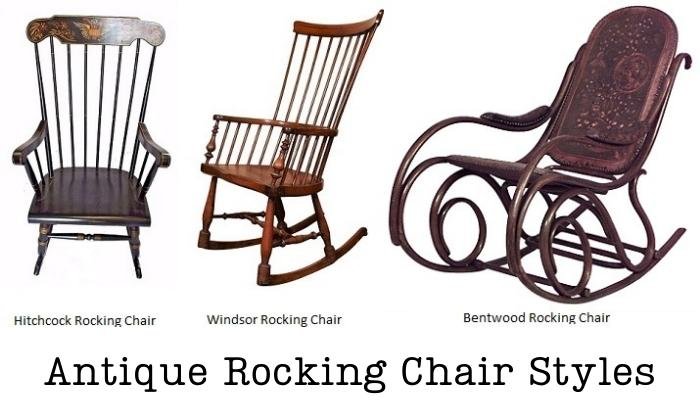One day, you decide to finally get rid of some junk collecting dust. You go up to your attic and look through some stuff. There you suddenly find a rocker, which you remember, was used by your grandfather. You want to know if it’s an antique or not. Well, to find the answer, read further below.
Table of Contents
How to Tell If My Rocking Chair is An Antique?
To be able to tell whether or not your rocking chair is an antique or not, you need to determine its age, type of material/wood, style & design, and manufacturer’s mark.
On an important note, for any furniture to be an antique, it must be over a century old and its crafted design should represent a specific time period. As a collectible, a rare and preserved antique rocking chair could be well worth $3,500.
Finding The Manufacturer’s Mark
By finding the manufacturer’s mark, you will get most of the information regarding its antiqueness. It could be of any type: a pencil-written label, stamped with brand marks, or even crafted logos. These marks are usually located on the back of the chair or on a spindle. In most cases, they will have the year of manufacture written on them, which will help you a lot in finding your rocker’s antiqueness.
The Type of Material

Since synthetic mixtures/plastic were not available in the early years, rocking chairs were made out of wood and were usually coated with oil and milk. If you can identify the type of wood your rocker is made of, you will get one step closer to your investigation.
Here’s a list of types of wood used back in the 1800s and 1900s and how to identify them:
- Maple wood: Like white oak, is one of the toughest woods. It has a light to medium weight and a clear white to creamy tint. However, maple does not tolerate humidity well, and it rots and stains rapidly. As a result, in order to last so long, the antique rocker should have been employed as interior furniture.
- Walnut wood: Often known as black walnut, it has one of the most beautiful wood patterns, with waves or curls and a pale to dark brown tint. It is relatively difficult to deal with and resists pressing and dents effectively.
- Pinewood: Has a light yellowish tone that darkens with age. It’s not too difficult.
- Oakwood: Is available in a wide range of colors, from clear white oak through chestnut and black. Because there are over 20 different species of oak wood, it is one of the most commonly utilized hardwoods. Oakwood, particularly red and white oak, is one of the toughest woods available and is very resistant to dampness and rot.
- Cherry: The color ranges from clear to medium reddish-brown, with largely straight lines.
- Birchwood: Textured wood with a linear, close-grained grain. It might be white, yellow, or red in color.
After finding out the material, you can generally tell from which time period your rocking chair is.
- Oak was the most prevalent type of wood used abroad from the Middle Ages to the 1800s, but walnut and mahogany became popular in the late 1600s.
- Walnut became popular in Europe in the late 1600s, but its popularity decreased by the mid-1700s.
- Colonial American furniture was constructed from American hardwoods such as oak, walnut, birch, and maple in the early 1600s and 1700s. This went on for centuries.
- Mahogany became popular in the mid-1700s and remained so in England and America until the mid-1800s.
Just got to a shopping center trying to buy a good rocking chair but you dont know what qualities to look for? Then Read 10 Qualities to look in a good camping rocking chair or click the image below:
Look at its Craftsmanship
Old chairs were made by hand, so this could also help in identification. You can examine its joints and design to figure out whether your chair is handmade or machine-made.
- If matched pieces, such as armrests or rockers, appear to have minor size variations, this is an indicator that they were handcrafted.
- Handmade joints will be formed using glue and pegs, giving them a coarser appearance, whereas modern joints will be clean and smooth.
- Early nails are square and imperfect, so if your chair has this style of nails, it may be a genuine antique.
- Because machine-made nails and screws were not invented until the mid-nineteenth century, their presence can suggest modernity.
Find Out its Finishing
Often, wooden rocking chairs were applied with a finishing coat to protect the wood. If you can identify the type of finish, it would help you pin down a certain time period where your rocking chair could be from.
- Shellac is commonly used to finish furniture built before 1860. Shellac that is in good condition has a deep glossy luster and is applied in thin layers.
- Lacquer and varnish were not created until the mid-nineteenth century. Lacquer in excellent condition is less glossy than shellac and significantly thicker when applied.
- Old varnish will frequently begin to peel off, revealing its identity.
- Oil, wax, and milk paint finishes are additional signs of extreme antiquity. It has a wax finish if it has a bright gloss and noticeable clumps of wax.
Antique Rocking Chair Styles

Here are three dominant rocking chair styles found throughout the world in early eras.
American Style Rocking Chairs
The Hitchcock chair is a rocking chair in the American style. The following characteristics were used in numerous American rocking chairs manufactured between the 1780s and the early 1800s.
- Straight Lined Body
- Low Relief Carvings
- Lightweight
- Inlaid Details (Usually found on the more expensive chairs)
In the early 1700s, wicker rocking chairs were quite popular in the United States.
English Rocking Chairs
The Windsor is a type of rocking chair that originated in England or Victorian-era America. The design of this chair is influenced by prior American shapes. Unfinished or waxed 1720s artworks were sold locally. While most American sculptures were painted.
- Curvilinear Body (Curvy Design)
- Lightweight to medium weight
- High Relief Carvings
Germany’s Rocking Chairs
In 1860, Michael Thonet, a German craftsman, designed the first functional bentwood design.
- Bentwood Rocking Feet
- Sides Made as One Piece
- Heavyweight
- Armrest Pads
Conclusion
As you can see, there are several elements to consider when determining the value of your antique rocking chair. The best thing you can do is find a respectable antique dealer and have them evaluate your rocking chair. Through this, you can get exact pricing.
Remember, you should first determine the condition, age, and brand of your rocker, before going to the market and selling it.


